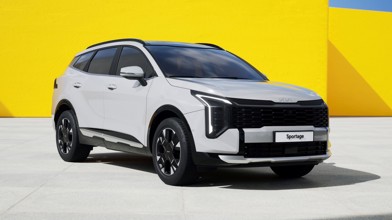The Jaecoo J7 is going to be the first model in Chinese manufacturer Omoda Jaecoo’s SUV sub-brand to land on our shores when it arrives sometime in the next few months.
The J7 shares its underpinnings with the Omoda C5 that is a recent arrival to the local market, but while the Omoda comes with a choice of 1.5-litre/CVT, 1.6-litre/7-speed DCT or all-electric powertrains, the J7 is likely to land here with either the 1.6-litre/7-speed DCT or a new 1.5-litre plug-in hybrid version with 255kW/525Nm and an electric-only range of up to 88km that was just revealed at the recent Beijing Auto Show.
Chery claims the J7’s PHEV powertrain boasts best-in-class thermal efficiency of 44.5% - most road legal car engines have thermal efficiency of between 20 and 40% - and that it has a total range of more than 1200km, with real world fuel consumption of 4.9l/100km.
Unlike most other PHEVs, the J7 boasts DC fast charging and V2L capabilities that allow it to act as a power source for external electronics.

While we got to take a closer look at the PHEV at the show, we also managed to briefly get behind the wheel for a quick taste of the petrol J7 at the same short track in the parking lot of an amusement park in Wuhu city where we got to sample the Jaecoo J6 (iCar 03).
A few laps around a short acceleration course with a few small chicanes on the return was all we got, but it was a tantalising taste of what we can expect when the J7 lands here in the next few months.
From the outside, the J7 is a handsome mid-size SUV with more conventional, squared-off styling than that of the more ornate Omoda C5 it shares its underpinnings with.
Much like the all-electric J6, the sheer quality of the J7’s interior is deeply impressive, not just being on par with what we have already seen in its Omoda C5 sibling but, if anything, a bit above that.
High quality seat and upper dash materials do a good job of hiding some harder plastics low down in the cabin, but even these feel of a good quality, while the level of tech and infotainment goodies are impressive.
Comfortable seats are nicely complimented by a plush ride, which does see it leaning quite hard on the outside front tyre through corners, but that body roll is beautifully controlled and any movement is nicely telegraphed to the driver. It’s soft, yes, but the blend between ride comfort and handling seems to be about right for a medium SUV. At least in an amusement park parking lot, that is.
Like its Omoda sibling, the J7 also has a distinct lack of strong self-centring to its steering, which is also extremely light and almost feels over-assisted. While this is actually more of an advantage in a car that is going to spend a lot of time running around town, it does become a bit frustrating on the open road.
That said, we don’t know what market spec the car we drove was, so this could be different in the cars we see in New Zealand.
From a very short taste, the pure-ICE Jaecoo J7 feels very similar to the Omoda C5 GT I drove recently and came away rather impressed by.
Sharing an engine and transmission with the J7, the C5 GT is priced at $37,990 for the 2WD model I drove, and featured a more sophisticated independent rear suspension set up that offers up a more settled ride than the standard C5’s torsion beam rear.
I would put money on the Jaecoo J7 sharing the superior rear suspension as well as its engine and suspension, as it had a similarly settled ride to the C5 GT.
Even though it was a very brief taster, the sheer level of quality and composure on show in the J7 impressed immediately, while the only real possible negative was related to steering feel, which is a personal thing anyway.
If Omoda Jaecoo land the J7 here at similarly aggressive pricing to the Omoda C5 (which looks extremely likely at this stage), then the Jaecoo J7 should offer up a truly convincing competitor in the medium SUV segment, with its handsome, more traditional SUV looks and impressive levels of quality.












